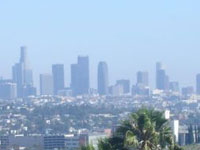Air Pollution Costs California Billions
 GLOBE-Net - The air is so unhealthy in parts of California that it causes the state to lose $28 billion in economic activity each year, says a study by two economics professors at California State University, Fullerton. Pollutants also cause more than 3,800 people to die prematurely.
GLOBE-Net - The air is so unhealthy in parts of California that it causes the state to lose $28 billion in economic activity each year, says a study by two economics professors at California State University, Fullerton. Pollutants also cause more than 3,800 people to die prematurely. Jane Hall and Victor Brajer focused on the Los Angeles region and the San Joaquin Valley, northwest of the megalopolis. They found air pollution levels in both areas rivaled only Houston, Texas in their severity.
“Most people cannot choose the air they breathe, and there is clear scientific consensus that people’s lives are shortened by air pollution. Kids are made sick. Workdays are lost,” says team-leader Jane Hall in the San Francisco Chronicle. Hall has researched the impact of air pollution for two decades.
Filthy air causes 1.3 million children to stay home from school and adults lose more than 466,000 days of work each year, says “The benefits of meeting federal clean air standards in the South Coast and San Joaquin Valley Air Basins” report. Asthma attacks affect 141,370 people; acute bronchitis fells 16,110 children and 2,800 land people land in emergency rooms annually because of deadly pollutants in the air.
Nearly every resident “regularly experiences air pollution levels known to harm health and to increase the risk of early death,” writes the report. Between 2005 and 2007, almost everyone in the Los Angeles region was exposed to unhealthful levels of ozone for more than 20 days each year. People living in the San Juaquin Valley were exposed to microscopic particulates for 30 days annually.
No time of year is exempt from dangerous pollution levels. People are exposed to high concentrations of ozone from April to September and breathe in dangerous fine particles during the rest of the year. “Not only is the standard frequently exceeded,” say the authors, “But between 2005 and 2007 the maximum 8-hour concentration was significantly above the standard.”
The researchers found that California’s productivity levels drop and costs increase when children miss school or their parents stay out of the office because of health-related concerns. Their doctors’ bills, for instance, are covered by insurance companies, but those costs are passed as higher premiums to customers living in other parts of the state.
The study finds that the price of air pollution in the San Joaquin Valley is more than $1,600 per person per year, or $6 billion of the region’s economy. Simply meeting federal clean-air standards would save the region that annual cost, say the authors. In the Los Angeles metropolitan area the cost exceeds $1,250 per person, which translates into $22 billion in savings if emissions came into compliance with federal standards.
The San Joaquin Valley has long suffered from some of the worst pollution in the United States. Fumes from heavy-duty diesel trucks and numerous automobiles pollute the air alongside large agricultural operations. Los Angeles suffers from temperature inversions that trap smog close to the ground and from exhausts spewed by millions of vehicles on the road.
Its pollution levels are lower than in the Valley, however, because winds from the Pacific Ocean push many pollutants to the east.
The American Enterprise Institute, according to the San Francisco Chronicle, says the mortality estimates may be overstated in studies that link exposure to ill health. The conservative think tank regularly comments on government health standards. The researchers, on the other hand, argue that their $90,000 study used data and a methodology widely accepted by the Environmental Protection Agency.
Governments may be wise to read the California study in these uncertain economic times. Reducing pollution levels does not just improve people’s health. It can save billions of dollars. The trick is whether businesses and consumers are willing to modify their behavior in an age when pinching pennies has become the new norm.
You can return to the main Market News page, or press the Back button on your browser.

